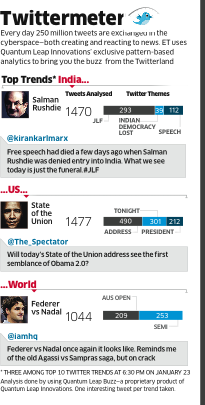In the middle of 2011, UK-based Derwent Capital started a hedge fund that used a Twitter feed to fuel their market analytics. They beat the market by 50 percent in their first month of operation. While they’ve been tight-lipped about the mathematics used by their resident “quants,” it’s clear that there is serious gold to be mined in these massive streams of social media that are spraying the world like a fire hose.
Enter Pattern Based Analytics from a little-known “spook shop” in Delaware. Since 1999 they’ve been delivering millions of dollars worth of find-a-needle-in-that-haystack projects to the U.S. Department of Defense. Over $32 million, to be precise. During the 2009 H1N1 flu pandemic, their simulations showed the government it would be stupid to close the boarder with Mexico or shut down airports. They’ve been used in Iraq and Afghanistan to search for patterns in roadside bombings as well as to deploy military assets for the Navy and the Air Force.
Their founder and CEO, Joseph Elad, tracked me down to show me Pattern Based Analytics. I don’t travel a lot and suggested we could get together in a few months when I was next on the East Coast. The next thing I knew, he showed up on my doorstep in Sandy, UT. Of course I invited him in. I pulled out my digital projector and let him show me his technology. Being a mathematician myself, I quickly saw something very different: a non-mathematician/statistician could use Pattern Based Analytics to let the data do the talking, revealing correlations and cause/effect relationships without the user needing a whole lot of domain expertise. Intriguing indeed.
He then posed the question: How does this technology make it in a market flooded with weekly announcements from new analytics startups, all choosing to break their respective picks going after major corporations?
Having just heard of Derwent Capital’s use of the Twitter fire hose for their hedge fund, I suggested that his company actually give away a Pattern Based Analytics demonstration and use the user’s own desktop to distribute the MIPS. The user would see the value in these unique and proprietary algorithms, and just maybe a small subset of those users would encourage their Fortune 2000-size companies to take a look at the industrial-strength products. The company couldn’t afford to set up server farms or buy an unlimited pipe from Twitter, so I suggested the product run on a desktop and use an anonymous Twitter query that Twitter could never shut down. He thanked me and went home, leaving me with that warm feeling that I’d sent him away with a better grasp of the problem than when he found me.
Less than 10 days later, Elad — the most Larry Ellison-like personality I’ve run across in 30 years — sent me the first version of a Pattern Based Analytics product designed to mine data from Twitter. I’ve been hooked on it ever since. One of the coolest features is that I set up a dashboard of trending topics I think are important and, when that topic gets some traction, the program sends a text message to my cell phone.
The product has taken on a life of its own. Whenever Elad’s company shows their high-end analytics to serious corporate adults, they always end the presentation with a demonstration of the Twitter product. And those same corporate adults get strangely excited by the little freebie demo.
Alas, it’s no longer a simple throw-away. Sure, it’s free until Leap Day 2012 (that’s February 29), after which they’ll be charging a whopping $10 per year. That’s not per month, but per year. Why Leap Day? Well, that’s because the name of the product — and the website — is Quantum Leap Buzz (from www.QuantumLeapBuzz.com).
How thoroughly addicting is the “Buzz?” Just this week, the world’s third-largest daily financial newspaper, The Economic Times, started running a daily feature on their back page that uses Quantum Leap Buzz to distill interesting trends for their readers. Like I say, The Buzz has taken on a life of its own. Here’s The Economic Times’ “Twittermeter” from Wednesday, January 25, 2012:

Full disclosure insists that I let you know I now sit on the Quantum Leap Innovations board of directors, along with MIT Distinguished Sloan Scholar Michael Cusumano. Also on the board is Steve Coltrin, a NYC-based PR legend well known to Silicon Valley luminaries. We all believe Pattern Based Analytics is the next Big Thing. But history will be the final judge. As will anybody who wants to try it for themselves. Buzz uses the same algorithms used in Quantum Leap Innovations’ industrial strength products. Oh, and did I say The Buzz is addicting?
Rick Bennett is the one-man ad agency that took Larry Ellison and Oracle from $15 million to $1 billion in annual revenue. He also created Marc Benioff’s pre-IPO ads attacking Siebel for Salesforce.com. He currently sits on the Safeguard Scientifics (NYSE: SFE) technology advisory board, as well as on the Quantum Leap Innovations board of directors. He lives in Sandy, UT and rides his bicycle 4,000-7,000 miles a year, training daily on 7,000-foot mountains. Twice a year he races at sea level and actually looks good against 20 year olds. Check Twitter @RickBennett for daily Quantum Leap Buzz insights. He is currently waiting for his literary agent to tell him whether or not his second novel has been sold. Contact him at rick@rickbennett.com.
